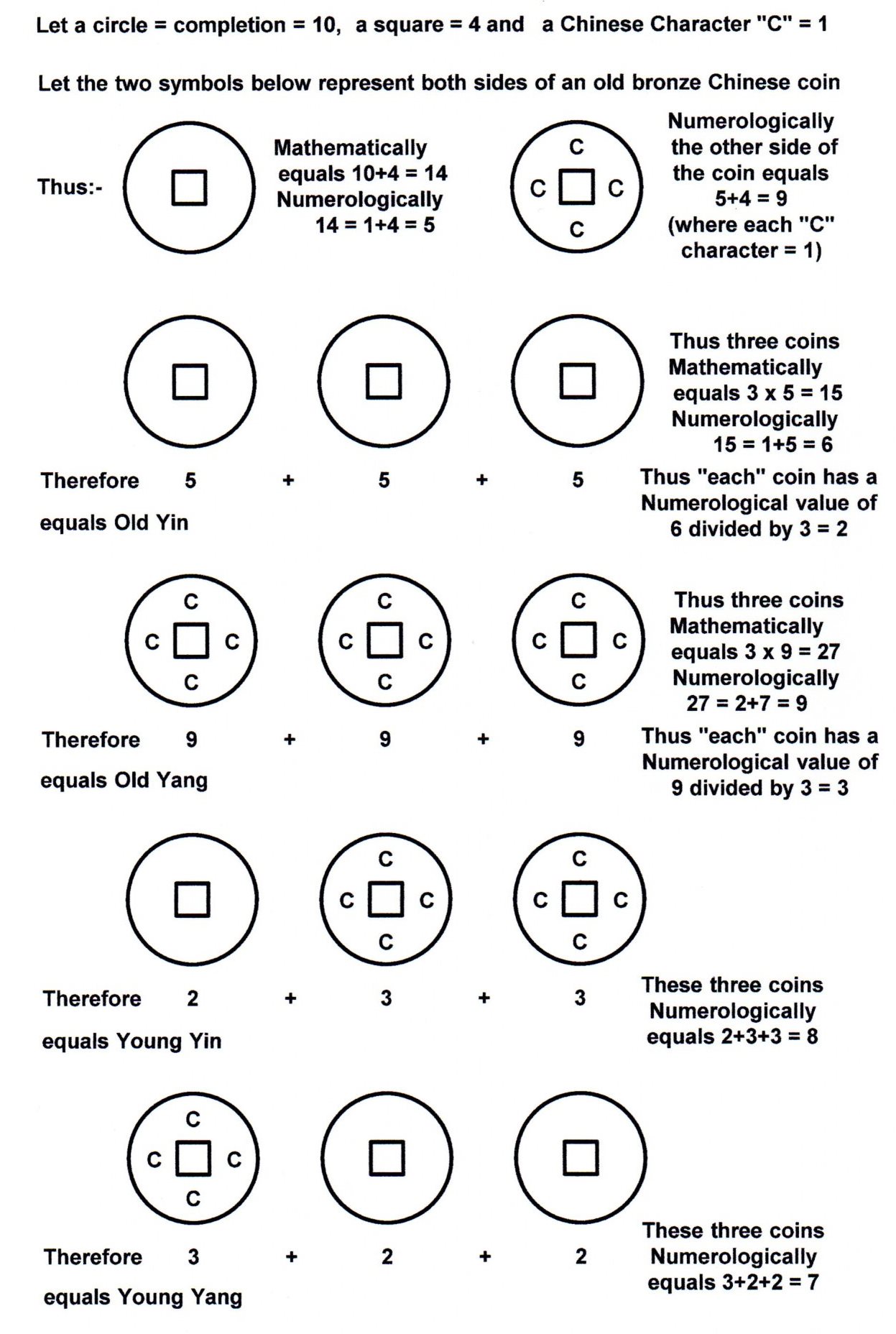|
The Coin Oracle
Each coin has a symbolic and numerical meaning Hexagrams, created by the coin prediction method consist of six lines
and are constructed from the bottom to the top, one line being determined by each throw of the coins.
To obtain the relevant hexagram, the three coins are thrown six times. For each toss of the coins there are four
possible mathematical combinations, which form the Rule of Line Symbolism Change, as follows:
a) Three Yang(heads) sides, represent Old Yang, a changing unbroken line, that is assigned the number 9. b) Three YIN(tails) sides, represent Old Yin, a changing broken line, that is assigned the number 6. c) One Yang(head)and two Yin(tails), represent Young Yang, an unchanging unbroken line, that is assigned the number 7. d) One Yin(tail) and two Yang(heads, represent Young Yin, an unchanging broken line, that is assigned the number 8. It should be noted, that a changing or moving line is one which changes to its opposite after the initial hexagram is obtained i.e.,
an Old Yin line changes to an unbroken Yang line, whilst an Old Yang line changes to a broken Yin line.
These particular lines are referred to in the I Ching text as "Nine in the beginning", "Six in the second place", "Nine in the third place", etc.
The number assigned to each line within the text of the I Ching is always a six or a nine. The number nine in effect indicates a Yang line and the
number six indicates a Yin line. It was generally thought that the four Chinese characters on the Yang side of each coin represented the four season of the year.
These were considered to be equal to one unit and have been assigned the number 3. The Yin side, which originally had no characters inscribed upon it now has two characters,
(these were added during the Man Ch'ing Dynasty and are known as the Man Chou characters) and have been assigned the number 2. When three coins are thrown, the sum, of the numerical values for each upper side of the coins, will produce one of the following
numerical notations, viz: 6, 7, 8, or 9, which are used to differentiate between the respective Yang / Yin changing and unchanging lines that are used to construct a hexagram. The assigned numerical value of each side of these old Chinese coins has always been accepted as de facto. No one, as far as I am aware has ever proven out these numerical notations in a satisfactory manner. The general explanation given for the numerical notation assigned to each respective Yang / Yin changing and unchanging line does not fit the facts. Given that there were only four inscribed characters on the Yang side and originally none on the Yin side of these ancient coins, we can deduce in a mathematical and numerological manner how the respective assigned values of 3 and 2 for the Yang and Yin side of these coins originally evolved. The round outer shape of each coin represents a circle. It is numerologically equal to the number 10 of completion. When number 10 is added to the square containing the four corners of the earth, this gives us the number 14. According to Vedic Mathematics, number 14 is numerologically egual to the sum of 1 plus 4. This forms number 5, representing the natural laws of the lower worlds of creation and the mathematical constants of perfection, incorporated within the pentagon. This number is the universal number of MAN, the 5-limbed microcosm strung between the two worlds of Heaven and Earth. The four Chinese characters, representing the four seasons, plus number 5 gives us the 9 as a tripod of the 3's which represents the Ting, a ritual vessel. Thus each coin has a spiritual meaning as well as a numerological value. In order to explore this further, the Yang and Yin side of the three coins were graphically represented in the combination order of the thrown coins. The assigned numerical notation value, deduced above, given to each coin face is as shown on the attached diagram on I Ching Vedic Numerology. By using mathematical and numerological reasoning, the assignen values of 6 and 8, 9 and 7, representing the respective Yang / Yin changing and unchanging hexagram lines, were determined as shown herein.
These particular numerical values are the same as those which are defined in Book II of the Great Treatise (Part 1, Chapter IX) and in the special section on the use of the oracle at the end of I Ching Book of Changes translated by Richard Wilhelm. In general terms, it means that: THE RULE OF LINE SYMBOLISM CHANGE Can be simply deduced as follows: A positive line _____ to a negative line __ __ = 9 (a change in line symbolism) A positive line _____ to a positive line _____ = 7 (no change in line symbolism) A negative line __ __ to a positive line _____ = 6 (a change in line symbolism) A negative line __ __ to a negative line __ __ = 8 (no change in line symbolism)
|
